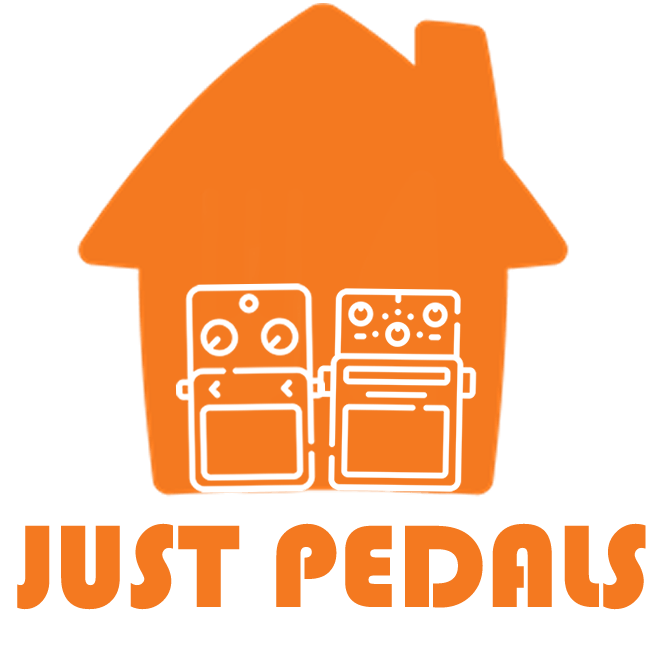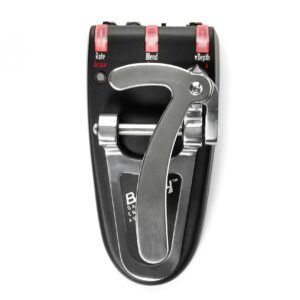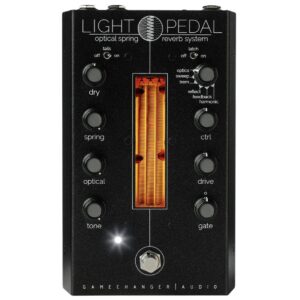Description
The Gamechanger Audio Third Man Records Plasma Coil Octave Distortion Pedal is in New condition and made by Gamechanger Audio , it is just a great Pedal Distortion Octave Coil Plasma Records Man Third Audio Gamechanger Guitar Effect Pedal- Gamechanger Audio Third Man Records Plasma Coil Octave Distortion Pedal . Available from Just Pedals for only £ 319 + delivery. Read More for details, demos & to order securely online.
About Gamechanger Audio
We have one of the largest online selection of new and used Gamechanger Audio music gear. If you are looking for your next pedal, we will have it online at JustPedals with fast delivery direct to you at home. Every item on the JustPedal menu is delivered by sellers to all areas of the USA & UK.
Gamechanger Audio is a Latvia-based boutique effects pedal manufacturer established in 2015, and recognized for its innovative approach to audio processing. The company focuses on pioneering new technologies and unconventional designs to redefine standard pedal functionality.
Their flagship products, such as the Plasma Pedal, utilize high-voltage arc discharge to produce a distinctive distortion effect, while the Light Pedal employs light-sensitive technology to control various parameters. Gamechanger Audio’s pedals are engineered to offer cutting-edge sound manipulation, incorporating advanced circuitry and novel techniques to provide unique sonic capabilities.
This emphasis on technological innovation and experimental features makes their pedals a compelling choice for musicians seeking to explore advanced and non-traditional sound sculpting options.
Distortion
A distortion pedal is a type of guitar effects pedal used to add gain, saturation, and harmonic distortion to the guitar signal, resulting in a more aggressive and gritty tone. Distortion pedals are widely used across various music genres, particularly in rock, metal, punk, and alternative styles, to achieve heavier and more intense guitar tones.
Here are the key features and functions of a distortion pedal:
1. **Gain (or Drive)**: The gain control adjusts the amount of distortion applied to the guitar signal. Increasing the gain setting increases the level of saturation and overdrive, resulting in a more distorted and aggressive tone. Lower gain settings produce a cleaner sound with less distortion.
2. **Tone**: The tone control adjusts the frequency response of the distorted signal, allowing you to tailor the tonal characteristics of the distortion effect. Depending on the pedal, the tone control may boost or cut specific frequency ranges, such as bass, midrange, or treble, to shape the overall sound.
3. **Level (or Output)**: The level control adjusts the overall output volume of the distorted signal. This allows you to match the level of the distorted signal with the rest of your effects chain or amplifier, ensuring consistent volume levels when engaging the pedal.
4. **Mode (or Voice)**: Some distortion pedals feature multiple modes or voicings that offer different types of distortion or gain characteristics. These modes may include options such as “Vintage,” “Modern,” or “High Gain,” each providing a distinct tonal flavor and level of saturation.
Distortion pedals offer several benefits and creative uses for guitarists:
– **Increased Gain and Sustain**: By adding gain and saturation to the guitar signal, distortion pedals increase the overall volume and sustain of the instrument, allowing notes and chords to ring out longer and with more intensity.
– **Tonal Shaping**: Distortion pedals often include tone controls that allow you to shape the frequency response of the distorted signal. This allows you to dial in the desired amount of bass, midrange, and treble to suit your playing style and musical preferences.
– **Emphasis of Harmonics**: Distortion pedals emphasize the harmonics and overtones present in the guitar signal, resulting in a richer, more complex tone with added depth and character. This can make lead lines and solos stand out and cut through the mix more effectively.
– **Versatility and Flexibility**: Distortion pedals come in a wide range of styles and voicings, from mild overdrive to high-gain distortion. This versatility allows you to choose a pedal that best suits your playing style, musical genre, and tonal preferences.
Overall, distortion pedals are essential tools for guitarists seeking to achieve heavier, more aggressive, and saturated tones. Whether used subtly to add warmth and edge to clean tones or used more aggressively to create crushing distortion, distortion pedals can enhance your guitar tone and bring new dimensions to your playing.
Guitar Effect Pedal
A guitar pedal, also known as an effects pedal, is a device used by guitarists to alter the sound of their instrument in various ways. These pedals are typically small, foot-operated units that are connected in a signal chain between the guitar and the amplifier. They can modify the guitar’s tone, pitch, and dynamics by applying different effects such as distortion, reverb, delay, chorus, and more. Guitar pedals come in both analog and digital formats, and they allow musicians to create a wide range of sounds, enhancing their musical expression and creativity. They are essential tools for guitarists in genres ranging from rock and blues to jazz and electronic music.
New
Just New products for sale, unused, and in their original packaging. They come with a protected seller guarantee and include manufacturer warranties. Read more for additional details.
Octave
An octave pedal is a type of guitar effects pedal that generates tones one or two octaves above or below the original signal. This effect can create a wide range of sonic textures, from thickening the sound to adding harmonies and creating synthetic basslines. Here’s how octave pedals work and some common features:
1. **Octave Up/Down**: Octave pedals typically offer the option to generate tones one octave above (octave up) or below (octave down) the original signal. Some advanced pedals may even offer both octave up and down simultaneously for more versatility.
2. **Blend Control**: Many octave pedals include a blend control, allowing you to adjust the mix between the original signal and the octave-generated signal. This feature enables you to dial in the perfect balance between the two for your desired effect.
3. **Tracking**: Tracking refers to how accurately the pedal follows the input signal and generates the octave. Higher-quality octave pedals have better tracking, meaning they accurately reproduce the pitch of the original note without latency or glitching.
4. **Polyphonic vs. Monophonic**: Some octave pedals are polyphonic, meaning they can accurately track multiple notes and chords played simultaneously. Monophonic pedals, on the other hand, work best with single notes and may struggle with chords.
5. **Sub-Octave**: In addition to octave up and down, some octave pedals offer a sub-octave effect, generating tones two octaves below the original signal. This can create deep, bass-like tones and add richness to your sound.
6. **Effects Loop**: Some octave pedals include an effects loop, allowing you to place other effects before or after the octave effect in the signal chain. This can open up creative possibilities for combining octave effects with other modulation or time-based effects.
7. **Expression Pedal Compatibility**: Certain octave pedals are compatible with expression pedals, which allow you to control parameters such as octave blend, pitch bend, or even the interval of the generated octave in real-time using your foot.
Octave pedals are widely used in various music genres, including rock, funk, jazz, and experimental music. Guitarists use them to create unique sounds, emulate basslines, and add depth and dimension to their playing. Whether you’re looking to thicken your tone, create harmonies, or explore new sonic territories, an octave pedal can be a valuable addition to your pedalboard.
Pedal
A pedal is an electronic device that alters the sound of an electric guitar by applying various effects. Pedals are typically connected in a series between the guitar and amplifier, allowing guitarists to switch effects on and off with their feet while playing.
This enables musicians to quickly and easily change their sound, adding versatility and creativity to their performances.
Pedals are essential tools in many musical genres, including rock, blues, jazz, and metal, allowing artists to craft distinctive and dynamic soundscapes.
Once you buy one, you can’t stop and then you have to sell them and buy more.













Reviews
There are no reviews yet.